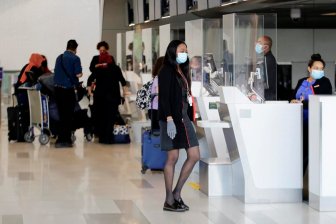Alberta’s chief medical officer of health explained why the province is taking a more cautious approach to easing COVID-19 restrictions this time around, compared to when the province relaunched the economy last spring.

Dr. Deena Hinshaw said Alberta is in a much different place right now than it was back in May when restrictions were lifted the first time. It comes as 259 new cases of COVID-19 and 11 additional deaths from the disease were reported Wednesday.
Hinshaw said while hospitalizations are down from a peak of 938 people on Dec. 30, there are currently still 539 people in hospital with COVID-19. That’s compared to the 57 people in hospital with COVID-19 when the economy relaunched in May following the shutdown last spring.
Additionally, there are currently 6,060 active cases of COVID-19 in Alberta. That’s compared to less than 1,000 active cases in May, Hinshaw explained.
“There are almost seven times the active cases today than there were at that time,” she stressed.
Hinshaw also noted variant cases of COVID-19, which are more easily spread, also put the province in a different situation. Higher overall numbers, higher hospitalizations and the variants pose a threat of exponential growth, she said.

Hinshaw said the province had identified 57 cases of the variant strains of COVID-19 as of Tuesday.
There were 50 cases of the B.1.1.7. variant, which was first discovered in the U.K, and seven of the N501Y.V2 variant, which was first discovered in South Africa.
“We are at a very different place than we were in May,” Hinshaw said. “It’s important that we take a slow, phased approach to ensure we are not doing too much too fast, especially as we learn more about the variants of COVID-19.”
Last week, Premier Jason Kenney announced the province’s four-step approach to easing restrictions in Alberta. The plan is largely based on hospitalization numbers.

Get weekly health news
Starting on Feb. 8, Step 1 will see restaurants allowed to reopen to dine-in service, fitness facilities will be able to offer one-on-one training and school-related sports will be offered again, with some restrictions.
Despite cases of the variants in Alberta, Kenney said earlier Wednesday that the plan to further ease COVID-19 restrictions is still scheduled to move ahead as planned on Feb. 8.
“Alberta has the best and the most aggressive testing regime for genome sequencing to identify these new variants, and we’ve also massively expanded our contact tracing system so we’re able to get on top of cases like this much more quickly,” Kenney said. “I think the new federal travel guidelines and restrictions, with respect to pre-testing, testing upon arrival and the enhanced quarantine measures, should all help to reduce future introduction of these various viral variants into Alberta.
“While we are right to be concerned about these variants, we did lay out last week a very careful, gradual and prudent path to reopening some aspects of economic and social activity, as we seek in a balanced way to protect lives and livelihoods. As we said, the key triggers will be based on hospitalizations, recognizing that at the heart of our effort against COVID-19 is controlling the spread so it doesn’t overwhelm our hospitals.”
Kenney said if the province moves back into significant viral spread and growth of COVID-19, measures may have to be tightened again.
“These are very limited — almost baby steps — towards reopening, but we need to recognize that we can’t suspend businesses indefinitely because many of them simply won’t survive that and the consequences there to people’s health, their mental health, their emotional health would also be devastating,” Kenney said.
“I know no one wants to be on the roller-coaster but we cannot guarantee people that there won’t be a change of policy in the future. We don’t want there to be, but what we’ve heard from these small business owners is they’d rather have an opportunity to operate for a period of time now while our numbers are coming down and the pressure is being relieved from the hospitals and, if necessary, in the future, should we see exponential growth we’ll have to act accordingly.”
Hinshaw said health officials will monitor the leading indicators of positivity rate, new case numbers and growth rate to see if the tide is turning and the province needs to pause before moving to the next step.
“This approach should limit the need to jump back and forth between easing and tightening restrictions, which I know is challenging for everyone, especially those whose businesses and paycheques are affected,” she said.
However, she did not specify exact thresholds for when reopening plans may be reassessed.
“We are looking at having a very low threshold,” she said.
“The specifics of those are being finalized, with respect to what would cause us to move backwards. But overall, our ultimate goal is to keep our case count trending downwards, is the ideal. Stable is possible but less ideal. And if cases start to go up again and positivity rate starts to go up again over a period of time of a few weeks, that of course will be a cause for concern and will trigger a discussion about whether or not we’re able to proceed with reopening as planned.”

Of the 539 people in hospital on Wednesday, 94 were being treated in intensive care.
The 259 new cases identified Wednesday came from more than 6,800 tests, which puts the province’s positivity rate at about 3.5 per cent.
Of the 11 deaths reported Wednesday, five were in the Edmonton zone. A man in his 80s linked to the outbreak at Laurel Heights Retirement Residence, a man in his 80s linked to the outbreak at Shepherds Care Vanguard, a man in his 90s linked to the outbreak at Leduc Community Hospital, a woman in her 90s linked to the outbreak at Benevolence Care Centre and a man in his 70s not linked to any known outbreak died. Alberta Health said all five deaths included comorbidities.
Three deaths were reported in the Central zone: a man in his 80s, a man in his 90s linked to the outbreak at Vermillion Health Centre and a man in his 80s linked to the outbreak at Seasons Camrose. Alberta Health said all three deaths included comorbidities.
Two deaths were reported in the Calgary zone: a man in his 50s with unknown comorbidities and a man in his 80s with comorbidities.
A man in his 60s with unknown comorbidities from the South zone also died.







Comments